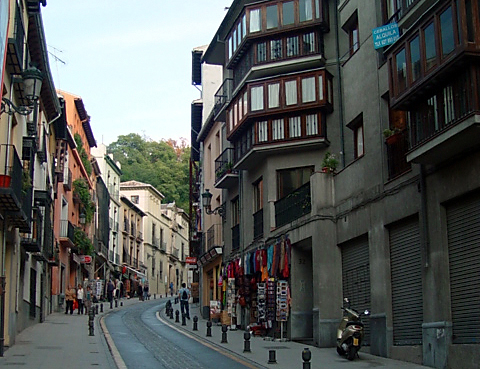Granada’s oldest city walls date from Iberian times; the most recent are from the early 1300s! The city’s narrow streets reflect its history. Some are so tight that “if two donkeys meet, they cannot get through.” People started to get cars in Spain in the 50s, and many now drive small Smart Cars, in order to navigate the narrow streets. There were also plenty of “streets that go nowhere”—dead ends.
We were surprised by the number of motor scooters speeding up steep streets and around tight corners. Several times as we were walking I heard the engine of an approaching vehicle, but, because of the circuitous configuration of the streets, I wasn’t sure which direction I should be looking to avoid an unfortunately close encounter. Nicolas said there are many accidents here because of the way young people drive, but we all emerged unscathed.
 The entrances to homes were often marked with a sign saying “Cármen” this or “Cármen” that. Who was Carmen? And did she really live in all these houses? We heard that cármen refers to the Arab word for grapes or vineyards; grape vines were often used to provide shade. On the hill across from the Alhambra is the Albaicin area, a fascinating labyrinth of narrow streets and whitewashed houses with secluded cármenes (inner gardens).
The entrances to homes were often marked with a sign saying “Cármen” this or “Cármen” that. Who was Carmen? And did she really live in all these houses? We heard that cármen refers to the Arab word for grapes or vineyards; grape vines were often used to provide shade. On the hill across from the Alhambra is the Albaicin area, a fascinating labyrinth of narrow streets and whitewashed houses with secluded cármenes (inner gardens).
 This area has a milder climate than the rest of the Mediterranean because of the Sierra Nevada mountains, and is a prosperous agricultural area. They are known especially for cherimoya (also called custard apple) and avocado. The area was once covered with pine, oak, and holly, with terraced farming initiated by the Moors. But use of wood for fuel—for hundreds of years—and the abandonment of terracing have left the hills almost entirely deforested. There are still mulberry trees: the silk industry flourished here in the Middle Ages. We heard: “Sugar beets and tobacco are now our most important crops. Tourism has become more important than agriculture. The ski resorts have been big since 1996. There has also been a lot of investment in real estate recently.”
This area has a milder climate than the rest of the Mediterranean because of the Sierra Nevada mountains, and is a prosperous agricultural area. They are known especially for cherimoya (also called custard apple) and avocado. The area was once covered with pine, oak, and holly, with terraced farming initiated by the Moors. But use of wood for fuel—for hundreds of years—and the abandonment of terracing have left the hills almost entirely deforested. There are still mulberry trees: the silk industry flourished here in the Middle Ages. We heard: “Sugar beets and tobacco are now our most important crops. Tourism has become more important than agriculture. The ski resorts have been big since 1996. There has also been a lot of investment in real estate recently.”
The prehistoric settlement at Granada was known as Ilbyr. Romans later colonized, and renamed the city Illibris. Arabs, arriving in the 8th century, provided its current name (probably derived from their word for pomegranate). Granada was the last Muslim city to fall to the Christians, in 1492.
We remember the Ruta del Veleta where we ate lunch in Granada I enjoyed the meal so much I asked our waiter for a couple of recipes. Here they are:
Tomato Appetizer
Parboil a whole tomato. Cool, remove skin, cut off the top. Remove seeds and fill with cooked tuna. Carefully place the tuna-filled tomato upside-down in a pool of salmorejo. Garnish with a skewer of hard-boiled quail’s egg, cheese cubes, etc.
Salmorejo
Make this just like gazpacho, but don’t use any vegetables except tomato: combine tomato, a bit of garlic, vinegar, oil, a little water, and bread.
Note: you can easily find more specific recipes for salmorejo on the Web, where I learned: 1. The bread should be dry, crustless, and cubed. 2. Let the bread soak for at least twenty minutes with the other ingredients, then blend (in a blender) until smooth.3. Chill overnight. 4. Adjust thickness, if needed, by adding ice water.
Dessert
First, make egg custard in a tray (I think he meant in a shallow pan). Let it settle (cool). Cut into squares, dredge in flour, and quickly fry each square in hot oil. Put on serving plate and pour on a sauce made of Grand Marnier or Courvoisier (it was reduced by about half). Garnish with thin strips of orange peel.
Story by Laurie McAndish King / Photos by Jim Shubin









